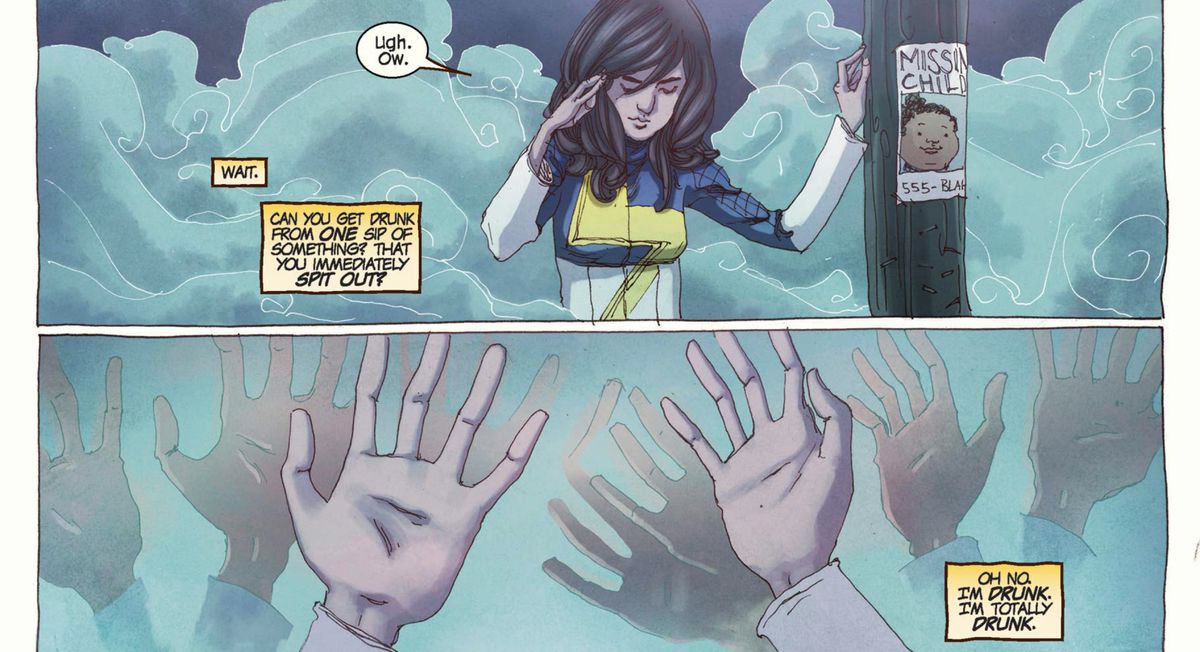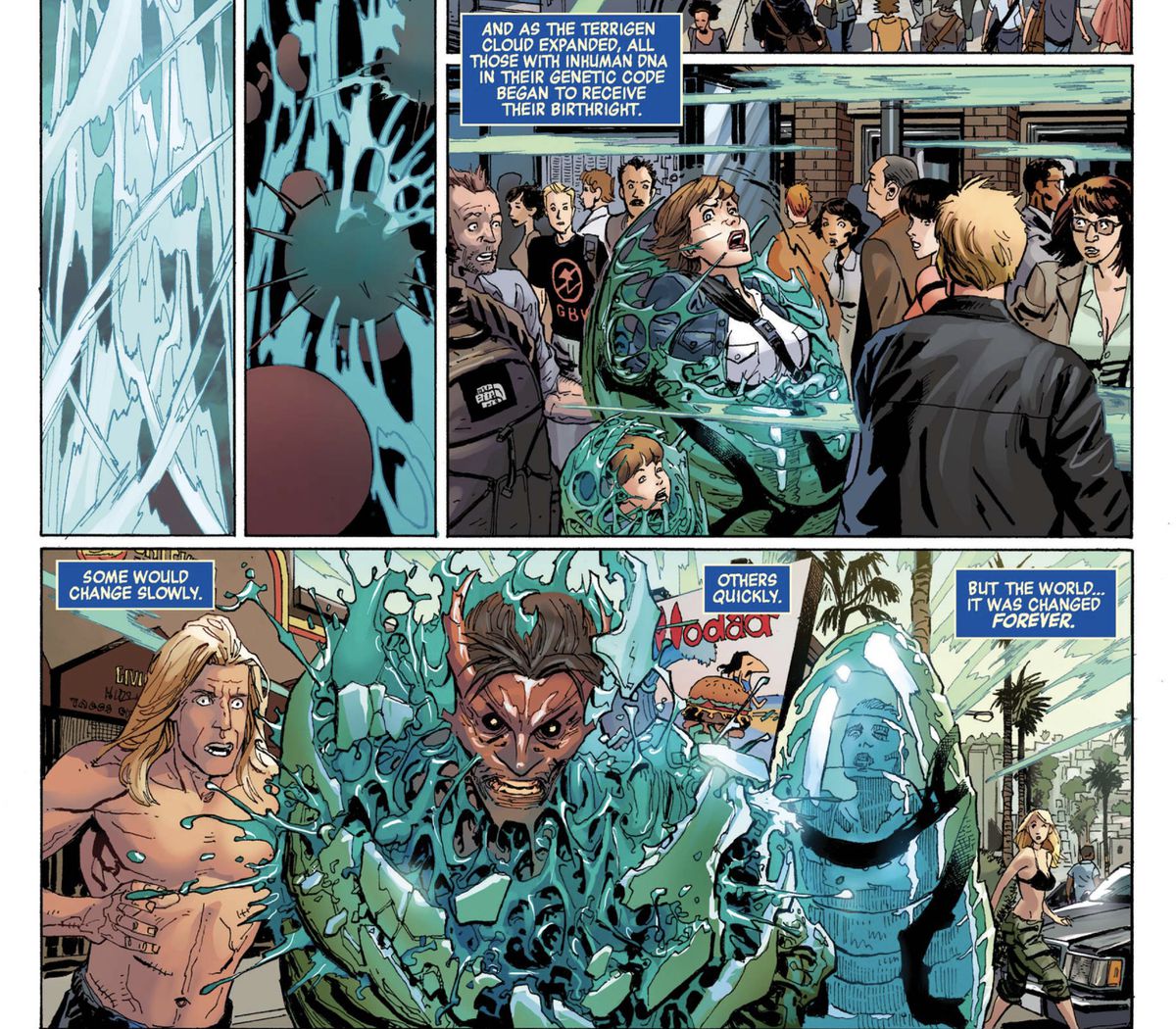It was clear from the trailers that Disney Plus’ Ms. Marvel would be making some departures from the comics, primarily in her superpowers. But it’s Kamala Khan’s origin story where the Marvel Cinematic Universe is likely to be making the biggest changes.
On paper, the story of how Ms. Marvel got her powers is merely weird. And when you zoom out to the level of corporations battling over the rights to Marvel Comics intellectual property, things get even weirder. So here’s why we’re definitely not going to see Kamala’s original backstory in her TV show — and why nobody is really surprised.
[Ed. note: This piece contains mild spoilers for the first two episodes of Ms. Marvel on Disney Plus.]
Image: Marvel Studios
In its second episode, Ms. Marvel makes it clear that the origin of Kamala’s bangle — a family heirloom from her great-grandmother — will be a central mystery in the show. It may be a few episodes before we find out more about her mysterious ancestor and the nature of this piece of jewelry that awards power over hard light constructs.
That mystery might lead a person to go look at how Kamala got her powers in the comics.
How did Ms. Marvel get her powers in the comics?

Image: G. Willow Wilson, Adrian Alphona/Marvel Comics
In her 2014 comic book debut, Kamala discovered that she was the descendant of an Inhuman when her superpowers were awakened by exposure to a cloud of Terrigen Mist created by the Terrigen Bomb. That sentence might lead a person to ask: “What in the heck does that mean? And… why? Why is it… like, like that.”
Hop in this time machine with me, reader, back to the year 2011. That was the first time that Marvel Studios appeared to be developing an Inhumans project for the Marvel Cinematic Universe.
Who the hell are the Inhumans? They’re a group of Marvel Comics characters originally introduced in The Fantastic Four by Stan Lee and Jack Kirby. Created after the X-Men and before the Eternals, they’re somewhere in between the two concepts. Like the Eternals, they’re a race of humanity that was genetically altered in the ancient past by extraterrestrial forces and lived on Earth in secret. But where the Eternals were nigh all-powerful and immortal, the Inhumans were driven to live in secret by superstitious, violent, and more populous ancient humanity.
In an analogous but much less relatable way to the X-Men, Inhumans were hated and feared. And in 2011, Marvel Comics was on high alert for anything that might be analogous to the X-Men.
Yep, we’re gonna talk about the 20th Century Fox X-Men deal
By 2010, the X-Men movie franchise, based on an exclusive film license to the X-Men purchased for a bargain basement price after Marvel’s 1990s bankruptcy, was a well-established moneymaker for 20th Century Fox. And the notorious head of Marvel Entertainment, conservative billionaire Ike Perlmutter, was reportedly cheesed off by the idea that Marvel Comics was still publishing what he saw as de facto advertisements for a rival company. Which is to say: X-Men comics.
Editorially, Marvel Comics adopted a quiet mandate to back-burner the X-Men in favor of bringing a different pot to a simmer. The Inhumans were fetch, and in the 2010s, both Marvel Comics and Marvel Studios were going to try to make them happen.
For Marvel Studios, that meant producing the MCU’s biggest flop, Inhumans the television show, and then promptly abandoning the entire concept except for a brief reference in Doctor Strange in the Multiverse of Madness. For Marvel Comics, it meant finding a way to create more modern and relatable Inhuman characters. The problem was that, in Marvel Comics canon, the process of unlocking an Inhuman’s superpowers was, unlike the X-Men, a very deliberate one: Inhumans were ritualistically exposed to a mutagenic substance called “Terrigen Mist.” You couldn’t just get a bunch of random humans waking up as Inhumans in the way that a teenager could wake up and discover their mutant powers.

Image: Jonathan Hickman, Jerome Opeña, Dustin Weaver/Marvel Comics
And so, during the 2013 crossover event Infinity, Black Bolt, the king of the Inhumans, detonated the “Terrigen Bomb,” releasing masses upon masses of clouds of Terrigen Mist into Earth’s atmosphere. Why did he detonate it? Well, he was fighting Thanos and— look, it doesn’t really matter; the important thing is wherever the clouds drifted, wherever they touched a person with traces of Inhuman DNA (i.e., whose ancestors had once had babies with an Inhuman) it zipped those people up in gross goop cocoons and activated their latent Inhuman abilities.
And that’s how Kamala Khan got her powers in the comics. She was walking hime from a party she shouldn’t have gone to, Terrigen Mist rolled in, she got cocooned, and she stepped out a shapeshifting, stretchy superhuman. Kamala’s instant success, from an editorial standpoint, was an outlier. Most of the new superpowered characters — or Nuhumans — that Marvel created with the Terrigen Mists plot line did not hit it big in any significant way (although Lunella Lafayette, the super-intelligent star of Moon Girl and Devil Dinosaur, is another Nuhuman who’s getting her own show soon).
And, needless to say, the Inhumans never became as popular as the X-Men.
Is Kamala an Inhuman in the Disney Plus show?

Image: Marvel Studios
It’s not clear.
Since the failure of Inhumans on ABC, the characters were abandoned by the larger Marvel Cinematic Universe. The actors who played them moved on to other projects, and the Terrigen Bomb is definitely not a thing. And so Ms. Marvel eschews any kind of cocoon or supernatural weather event in favor of a family heirloom and an icy generational silence surrounding Kamala’s great-grandmother.
So far, the series appears to be tying Kamala’s powers to her family in a way that they simply aren’t in the comics. Sure, in the comics, her family did struggle through the Partition of India, and her great-grandmother did have a bangle in which she hid the family’s money as they traveled, which was passed down from mother to daughter to Kamala. But it’s not magical, it’s just meaningful. And Kamala’s comic book abilities are technically derived from her genetics, but on such an ancient level as to amount to pure chance.
A connection back to Kamala’s great-grandmother could still be leading to a “Kamala is descended from a race of superhumans” reveal — but with the reduced state of the Inhumans in the MCU these days, it seems more likely that this is a brand-new origin story, possibly even one that’s completely disconnected from other Marvel properties. If anything cosmic is going on, there are other, more central kinds of nonhuman folks that Kamala’s great-grandmother could turn out to have been.
Maybe she’s an Eternal, a similar-to-the-Inhumans property that is actually of going interest to the current architects of the Marvel Cinematic Universe. Or maybe Kamala’s great-grandmother was a member of the Kree, the alien race that featured largely in the MCU origin of Captain Marvel. That would both bring Kamala’s MCU origin closer to Carol’s current Marvel Comics one, and give her a direct connection to Carol in advance of her appearance in The Marvels, the upcoming sequel to Captain Marvel.
We won’t know for certain until Ms. Marvel reveals more of its take on Kamala’s origin story.

